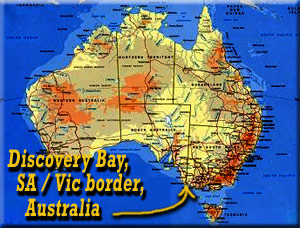|

Discovery at Bayby BushducksTelegraph Road. The name alone seemed to carry a message. Surrounded by coastal heathland in this far western corner of Victoria it was a temptation we could not resist. Dirt soon turned to sand as Rover followed the two tyre tracks to the northwest. From here, it was all smooth sailing. Correas, banksias, common heaths wattles and crimson rosellas greeted us as we approached the southern boundary of Mount Richmond National Park. T'was later we made the discovery that this picturesque track is the very route of the first telegraph line between Adelaide and Melbourne. It seems many a message has traveled this track as early as 1857. The main one we received was to keep going - that further discoveries lay at bay. Proceeding to Mt. Richmond to take in the magic views to the coast and up north to Gariwerd (the Grampians), we passed various tracks that are now restricted to foot power only. Morton's Track, Hanns Track, South Fire Line, Emu Hill Track and others all offer a treasure of flora and fauna including emus and their chicks. The coming spring is the classic time for the chicks. Our video batteries let us down when Mum, Dad and the chicks suddenly appeared in front of Rover - most annoying! Mt. Richmond, a volcano extinct by over two million years. is made of porous rock consisting of volcanic ash that has slowly hardened over time. This in turn is covered with sands blown from the nearby long beach, Discovery Bay. As a result you'll find no rivers on the mount. Instead the rainfall seeps through the sands forming many swamps and feeding the heathlands. These in turn are home to many cockatoos, honeyeaters, robins, wattlebirds and many others we couldn't identify.
Once down we found some lovely grassy camping areas just before you cross the dunes proper, with not a soul in sight. We decided that this was our Rover-home for the night. Rover could rest now, we wanted to stretch our limbs, so we headed off to nearby Swan Lake and Malseed Lake. Both consist of waters collected from the background hills before they seep through the sandunes. We could sit and watch the evening 'roos and bird s appear and disappear. Thinking we were the lucky ducks, we returned hungry and thirsty to lonely Rover only to find him surrounded by stickybeak 'roos of all sizes sniffing and nose-poking all around him. Rover and his new friends looked happily at home at yet another bush campspot. Hop, hop . . . hop they moved a polite distance away to resume grazing as we put some bush tucker on the gas ring, grabbed a cold beer and headed for the nearby sandunes to catch the last of the setting sun. Tops!
The sea-mist that rolled in during the night was pierced by the early morning rays as Rover shook the sand from his sills and deflated his tyres to take the track to the beach. Access here is controlled by Portland Dune Buggy Club. An immediate steep sand dune keeps out all but buggies and 4WD's. The track is marked by directional arrows and snakes through the soft dunes down to the beach. Tall flag essential! Being caught unprepared without a flag we improvised - a pair of Donald's bright red underpants soon fluttered from the CB aerial. Wondered why those emus seen scurrying over the dunes were chuckling to themselves. Beach driving being prohibited in Victoria, we returned the same way to reinflate Rover and continue on. Back to the sealed Nelson-Portland Road before turning off again through the pine forest down Bong Bong Road to another magic little area. Lake Mombeong (or Lake Bong Bong as it is called on some maps) is another freshwater lake, fringed by reeds. A small wooden jetty allows for paddlers to further explore the lake, or as a launching point for swimmers. A couple of small campsites are hidden in the teatree. From here we strolled the couple of kms to Nobles Rocks along the wide, white Discovery Bay. Surf fishermen love these rocks, although there wasn't a snapper in sight when we wandered past. From here too, a foot track, part of the Great South West Walk leads back 16.5 kays to Swan Lake winding through the dunes or along the beach, whichever way takes your fancy.
The site of Nelson, sitting on the mouth of the Glenelg River was first written about by Major Mitchell as he boated down the wide, still Glenelg river hoping to find a suitable harbour to open up Australia Felix for trade. The shallow basin at the mouth of the river had scarcely enough water to float a duck, so disappointed, he retraced his steps inland back towards Dartmoor. Nowadays Nelson is a summer home to many people, it boasts a small general store, boat hire and the Nelson Hotel, established in 1848. A wide variety of accommodation from caravan parks to guest houses and motels would tempt Major Mitchell to abandon his tent on the Glenelg. The steak was succulent and the fishing stories rife as we tucked in at the front bar of the hotel. So good, we thought we might stay awhile. Rover Bay? Doesn't sound quite right. Maybe we had better change our vehicle.
Portland Dune Buggy Club, Ph :(055) 292 468 for enquiries regarding access.
© Bushducks 1994
Be informed when this site is updated: |